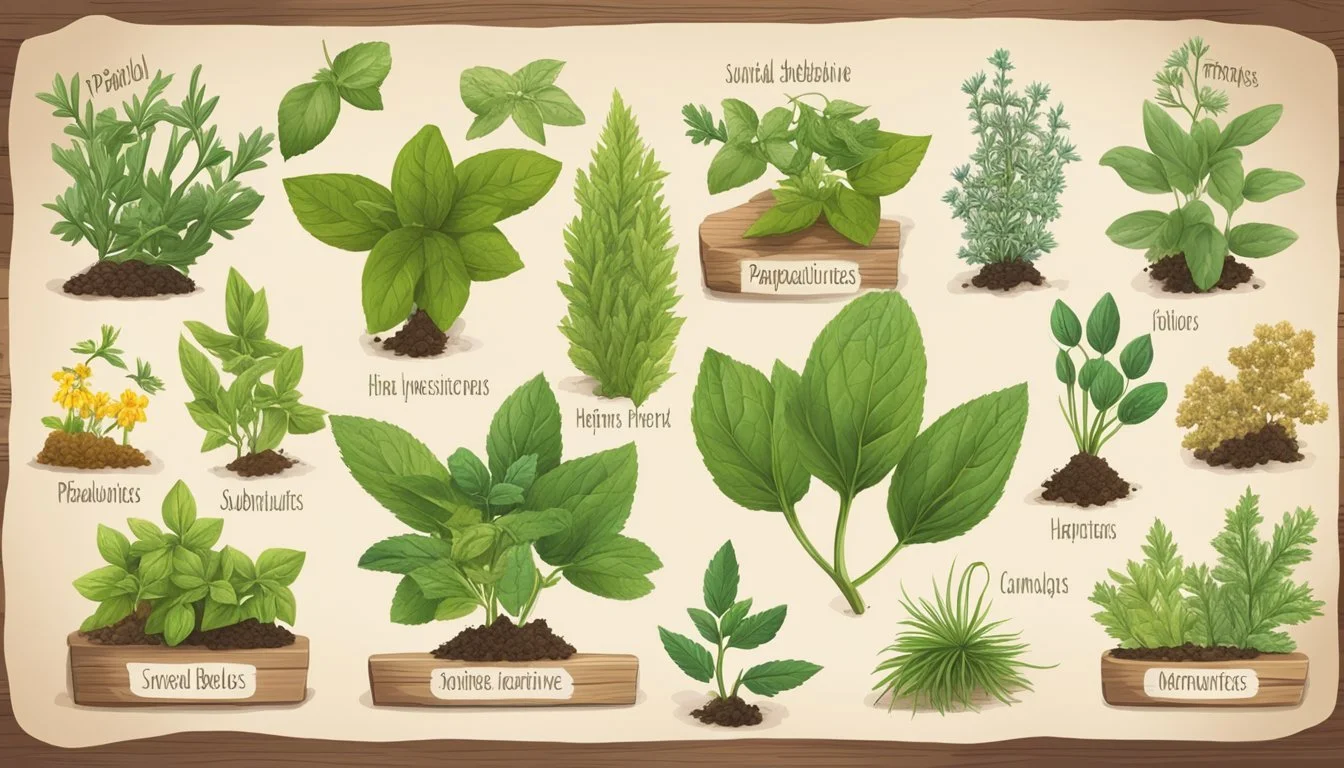Papalo Substitutes
Best Alternatives for Unique Flavor
Papalo, a vibrant herb common in Mexican cuisine, boasts a unique flavor profile that combines the freshness of cilantro with a hint of arugula and mint. When you can't find Papalo, there are several excellent substitutes to keep your recipes authentic and flavorful. This blog post delves into these substitutes, providing direct answers and useful tips for your culinary adventures.
Rau ram, also known as Vietnamese cilantro, closely mirrors Papalo's aromatic and slightly peppery taste, making it a fantastic replacement in various dishes. Thai basil, with its sweet and slightly spicy notes, also offers a compelling alternative, particularly in fresh salads and salsas. By exploring these substitutes, home cooks can maintain the distinct essence of their favorite Mexican recipes.
Understanding Papalo
Papalo is a Mexican herb renowned for its strong, cilantro-like flavor and unique aroma. This plant, scientifically known as Porophyllum ruderale, is widely used in various Mexican dishes such as salsas and tacos.
Origins and Culinary Uses
Papalo has its roots in Mexico, where it thrives in the warm climate. Regarded as a staple in Mexican cuisine, it is used to enhance the flavor of salsas and tacos. Traditional recipes often call for fresh papalo leaves to be added just before serving.
It is a versatile herb that can substitute cilantro in various dishes, offering a similar but more pungent flavor.
Taste Profile and Aroma
The taste of papalo is often described as pungent and cilantro-like, with hints of arugula and mint. Both the broadleaf and narrowleaf varieties can vary in flavor intensity. The broadleaf variety tends to be more palatable.
The aroma is distinctive and strong, contributing significantly to the dish’s overall flavor profile. Users should start with smaller quantities to avoid overpowering the dish.
Plant Characteristics and Growth
Papalo (Porophyllum ruderale subsp. macrocephalum) is a hardy plant that prospers in warm, sunny conditions. It grows well in USDA zones 4 through 9, between three to four feet tall. Its leaves are blue-green and scalloped, making it an attractive addition to any herb garden.
The plant prefers full sun but can tolerate some partial shade. For optimal growth, ensure it receives plenty of light and heat.
Cilantro and Its Role in Cooking
Cilantro, also known as coriander, is a versatile herb used in various cuisines worldwide. It offers a fresh, green color and unique flavor profile, making it essential in many dishes.
Comparison with Papalo
Papalo and cilantro are often compared due to their similar uses in cooking. Cilantro boasts a more delicate flavor with fresh, citrusy notes, while papalo has a stronger, more pungent taste.
Where cilantro loses much of its flavor when cooked, papalo maintains its robust character even under heat. Cilantro is preferred for its mellow, adaptable nature, suitable for garnishes, marinades, and sauces. Papalo, being more potent, is better in small amounts and often added at the end of cooking or used raw.
Cilantro in Global Cuisines
Cilantro holds a prominent place in many global cuisines. In Asian dishes, it’s used in soups, salads, and stir-fries, adding freshness. Indian cuisine incorporates cilantro both as a garnish and in chutneys and sauces, enhancing flavor and color.
Middle Eastern recipes feature cilantro in tabouleh and marinades. Latin American cuisine sees cilantro in salsas, tacos, and guacamole, integrating seamlessly with other ingredients. American cooking often uses it to garnish dishes, making it a vibrant addition.
This herb's versatility in various culinary traditions highlights its global importance and wide-ranging appeal.
Popular Papalo Substitutes
Finding suitable substitutes for Papalo can enhance various culinary dishes, bringing in flavors that closely match its unique taste. This guide breaks down the best alternatives in different types of cuisine.
Substitutes in Mexican Dishes
Papalo is frequently used in Mexican cuisine. If it’s unavailable, Cilantro is the most direct replacement. It offers a similar fresh, citrus-like flavor that works well in tacos and salsa verde.
When Cilantro is not an option, Fresh Italian Parsley serves as a reliable alternative. Though less pungent, it can complement guacamole and sandwiches due to its slightly bitter taste.
For those who prefer a bit more variety, Dill can also be considered. Dill’s slightly tangy, earthy notes can enhance dishes like salads and soups, providing a flavor profile distinct from but still reminiscent of Papalo.
Alternatives for Asian Recipes
In Asian recipes, many ingredients can stand in for Papalo. Thai Basil is an excellent choice for curries and soups. Its aromatic, slightly sweet flavor can bring life to various dishes, closely matching the unique components of Papalo.
Cilantro is another versatile substitute frequently used in Asian cooking. It complements the flavors of curries, broths, and stir-fries effectively. Its fresh aroma and slight citrus taste add a familiar touch.
For dried herb needs, Coriander Seeds can replace Papalo. These seeds, ground or whole, provide a warm, spicy flavor, ideal for richer dishes. Mint Leaves also serve well in fresh dishes due to their cool, refreshing taste that can harmonize with other herbs.
Substitutes Suited for American and European Dishes
In American and European dishes, Papalo’s substitutes need to blend seamlessly without overpowering the main ingredients. Flat-Leaf Parsley is a strong candidate, with its mild peppery flavor fitting well in salads, dressings, and sauces.
Chervil offers a subtle taste, making it an excellent addition to European cuisines like French soups and tarragon chicken. It brings light anise tones without overwhelming other flavors.
For an herb that covers a broader range of flavors, Tarragon can be employed. Its slightly sweet and licorice-like notes make it a versatile option for sauces and dressings, enriching dishes like béarnaise sauce and vinaigrettes.
Alternative Herbs and Their Flavor Profiles
When seeking substitutes for Papalo, it’s important to consider herbs with citrusy, peppery, or mild flavors to ensure your dish maintains its intended taste. Here are some suitable alternatives and their distinct flavor profiles.
Herbs with Citrus Notes
Cilantro and Thai Basil are well-known for their citrusy undertones. Cilantro boasts a bright, fresh taste with hints of lemon, making it a favorite in many global cuisines. Thai Basil, with its anise-like notes, also provides a citrusy zing and fits well in Southeast Asian dishes.
Parsley serves as a versatile option, particularly Italian Parsley. While more subtle than cilantro, it has a fresh, slightly peppery, and citrus hint that can substitute for Papalo in certain dishes.
Herbs with Peppery Tastes
Herbs like Basil, Oregano, and Rau Ram (Vietnamese Coriander) are excellent options for those who prefer a peppery kick. Basil, especially the common Italian variety, has a sweet and peppery profile that works well in both raw and cooked dishes.
Rau Ram, or Vietnamese Coriander, is a potent herb with a robust peppery taste, bridging the gap between cilantro and basil’s flavor profiles. Dill also offers a slightly tangy, aromatic pepperiness that complements dressings and salads.
Herbs with Mild Flavors
For a more subdued taste, consider herbs like Celery Leaves, Tarragon, and Mint. Celery Leaves have a delicate, slightly bitter flavor that can provide texture and subtlety without overpowering a dish. Tarragon adds a mild aniseed taste, suitable for sauces and lighter preparations.
Mint, although more pronounced in its sweetness, has a refreshing and mild flavor profile that can replace Papalo in certain contexts, especially in cold dishes and beverages. Italian Parsley is another mild-flavored herb that can blend well without altering the overall balance of the dish.
Essential Tips for Substituting Herbs
Choosing the right herb substitute involves maintaining flavor balance, understanding the differences between fresh and dried options, and even growing your own alternatives to ensure the best quality and taste.
Maintaining the Balance of Flavors
When substituting herbs, it's crucial to maintain the desired flavor profile. For example, papalo can substitute for cilantro due to its similar yet more robust taste. Use a ratio like 1 tablespoon of papalo for 3 tablespoons of cilantro to achieve a comparable flavor.
Consistent taste calibration ensures that your dish retains its intended essence. Trial and error may be necessary, so consider experimenting with small quantities first.
Considerations for Fresh vs Dried Substitutes
Fresh herbs and dried herbs often require different substitution ratios. For instance, dried herbs are generally more concentrated, so you might use 1 teaspoon of dried herbs for every 1 tablespoon of fresh cilantro. The flavor intensity changes, so adjust accordingly.
Dried cilantro may offer a less vibrant flavor, making fresh substitutes like papalo or Thai basil preferable. Always taste and adjust to achieve the best result.
Growing Your Own Substitutes
Gardening enthusiasts can grow their own herb substitutes. Papalo, for instance, thrives in full sun and warm climates, ideal for USDA zones 4 through 9. Plant seeds in a seedling box under a thin soil layer, keep the soil moist, and place in a bright, warm area.
Expect germination within 2-3 weeks. Growing your own ensures access to fresh herbs, enhancing the quality and flavor of your dishes. It's a sustainable approach providing control over the herbs you use.




